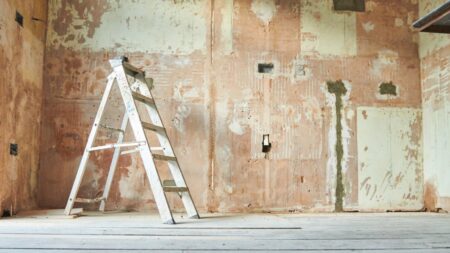Homeowners in the U.S. pay an average rate of $2,285 per year for $300,000 in dwelling coverage (as of October 2024). But how is home insurance calculated? And how can you estimate homeowners insurance costs while you’re searching for a new home? Rates are based on a broad range of factors, including your home’s age, location and the materials used to build it. Bankrate created this guide to help you understand how insurers determine premiums so you can better estimate how much you might spend on a home insurance policy.
How is home insurance calculated?
Insurers consider several factors specific to the homeowner and the home when calculating homeowners insurance costs. Having the necessary information available beforehand can make the process go more smoothly. The company’s calculations will take into account the cost to rebuild your home and other structures, replace your personal property and cover legal or medical costs if there is a liability claim made against you. Your quote is also likely to take into account the cost of temporary living expenses while your home is being repaired following a claim.
Here are some things to consider as you begin to estimate your home insurance costs.
How to estimate homeowners insurance
1. Estimate how much it would cost to rebuild your home
Estimating your home’s rebuild cost is the first step in calculating the cost of home insurance. This figure determines your dwelling coverage amount, which is the limit your insurance company will pay to repair or rebuild your home after a covered claim. The rebuild value is just one factor that will impact your home insurance rates, but it’s important since your dwelling coverage typically determines the other coverage limits on your policy.
Keep in mind your home’s rebuild value is not the same as its market value. A home’s market value includes the land and is influenced by outside factors, like supply and demand. When you determine your rebuild value, the dwelling coverage is based on how much it would cost to rebuild or repair your home.
The cost to rebuild your home depends on several criteria, including:
- Your home’s age
- Total square footage
- Age and type of heating, electrical and plumbing systems
- Building materials
- The foundation type
- Its roof type and materials
- Any unique or custom building features or characteristics
- Current cost of labor
Insurance companies input these details in their valuation tools to calculate the home’s replacement cost. Since each company has its own proprietary rating algorithm, the calculated amount can vary by insurer, but it is the amount the insurer will base the dwelling coverage amount on. Knowing your home’s characteristics and providing these details to an insurance agent or company will help you accurately determine the cost of rebuilding your home’s structure.
Bankrate insight
If you overvalue your home’s rebuilding cost, you’ll end up paying for coverage that you don’t need. If you underestimate your home’s rebuilding cost, you run the risk of being underinsured. When in doubt, consulting with a licensed insurance agent is key in determining the appropriate amount of dwelling coverage for your policy.
2. Estimate the value of your assets
Next is estimating the value of your assets. The personal liability coverage on your home insurance policy may cover costs if you are sued or held legally liable for another person’s injuries or property damage. Liability claims may include:
- Dog bites
- Trampoline injuries
- Pool injuries
- Someone injuring themselves in your yard or home
- Someone in your household damaging someone else’s property
To determine your personal liability needs, calculate your total assets. This means all properties you own, possessions and vehicles. Most insurance companies have a cap on personal liability coverage. However, some high-value home insurers may offer higher liability amounts. If your assets exceed a company’s personal liability coverage, it may be worthwhile to buy umbrella insurance, which kicks in if you exhaust the underlying liability limits on your home and auto policies.
3. Estimate the value of your personal property
A good insurance policy is also likely to cover the replacement cost of your personal belongings, from clothing and appliances to electronics and furniture, if they are damaged or destroyed by a covered peril. You will be responsible for paying your deductible in the event of a claim, and your coverage only extends to your policy’s limits, so it’s important to accurately estimate how much your belongings are worth.
Usually, personal property insurance covers your belongings at a rate of 50-70 percent of your dwelling coverage. But what do you do if you have, for example, an expensive collection of artwork or pricey electronics? If you have high-value items, you may want to consider adding a scheduled personal property endorsement to your policy. This provides more robust coverage.
Determining how much personal property coverage you need can be challenging. One tactic that can make it easier is to create a home inventory of your belongings. You might do this by walking through each room of your house and taking videos or photos of all your possessions so it’s easier to itemize their value when filing a claim. Keep receipts and serial numbers in a safe place, and consider obtaining a professional valuation of high-cost items such as artwork.
One final consideration is whether you want your possessions covered on a replacement cost basis or for actual cash value. The latter takes into consideration the deprecation of an item over time. If you have actual cash value coverage, you’ll receive a lower payout than if you have replacement cost coverage, especially if many of your belongings are on the older side, but you’ll also pay less for your coverage.
4. Determine how much standard coverage you need
Now that you have all your values for your home insurance cost estimate, it’s time to determine how much home insurance coverage you need. If you want replacement cost, your policy should reflect at least the minimum values you determined for your home and personal property. Read your paperwork carefully or ask an agent if replacement cost coverage is included in your policy. If it is not, ask to add it as an endorsement.
Following are the types of coverage included in standard policies and details about each:
- Dwelling coverage: Pays to repair or replace the structure of the home.
- Other structures coverage: Covers detached structures on your property, such as a fence, detached garage, driveway or treehouse. Other structures coverage is typically 10 percent of the dwelling amount.
- Personal property coverage: Pays to replace or repair your belongings, usually 50 to 75 percent of the dwelling coverage amount.
- Personal liability coverage: Covers legal expenses if you are held legally responsible for someone else’s injuries or property damage, plus their medical expenses.
- Loss of use coverage: Also called additional living expenses, this coverage pays for increased living costs, including food, laundry and lodging, if your home is temporarily uninhabitable after a covered loss. Loss of use coverage is usually 20 to 30 percent of your dwelling coverage, but some insurers have a time limit rather than a percentage limit.
- Medical payments coverage: Pays up to a certain dollar amount for medical expenses if a guest is injured on your property. In these cases, you are not legally liable for their injuries but still want to help cover their medical costs.
5. Determine whether you need additional coverage types
Most insurers offer endorsements, or optional riders, that allow you to personalize your policy to better reflect your circumstances. In some cases, you may be required to include these insurance types (for example, if your mortgage lender specifies that you must carry certain coverage as a condition of the loan).
Some endorsements are region-specific. A common example is flood insurance. Floods are not covered by standard home insurance policies, but if you live in a designated flood zone or if you have a mortgage, your lender may require you to purchase flood insurance to protect the financial institution’s interest in your home.
Even if you’re not required to carry additional coverage types, it can be worth considering them for better financial protection from a broader range of circumstances. A licensed insurance agent can help you determine what, if any, endorsements or additional policies might be worth considering.
Endorsements and separate policies can include:
Bankrate insight
If you’ve made environmentally friendly upgrades to your home, you might benefit from specialized coverage options due to the increased cost of going green. Some companies (Travelers, for instance) not only offer an endorsement to help cover the extra cost to replace environmentally friendly building materials after a covered claim but also a potential green home discount.
How is home insurance calculated by insurers?
There is no standard formula to calculate homeowners insurance. Each company uses a proprietary underwriting algorithm that weighs your underwriting characteristics differently (your ZIP code, loss history and roof age, for example). Your rebuilding cost is only one piece of the puzzle.
That said, home insurance quotes vary from company to company. Perhaps the best way to estimate your homeowners insurance cost is to compare home insurance quotes from multiple carriers (making sure to request the same or similar coverage levels across the board).
If you’re struggling to estimate your rebuild cost (and thus, how much dwelling coverage to quote), you may want to research average home building costs in your area, with the goal of finding the estimate to rebuild a home per square foot. Once you know the average home rebuild cost in your area, you can multiply this figure by the square footage of your home.
For instance, let’s say you spoke with several local contracting companies and found that, on average, the home rebuilding cost in your area is $200 per square foot. Your home is 1,200 square feet. To calculate the approximate cost of rebuilding your home, you could use the following formula:
($200) x (1,200 sq ft) = $240,000 approximate home rebuild cost
If you recently purchased a home or are in the market to buy a house, you may also use the appraisal to help estimate the dwelling value. While this information can help give you a baseline of how much dwelling coverage to quote, property insurers use their own valuation tool to calculate the actual total of your home’s dwelling amount and annual premium.
How much does homeowners insurance usually cost?
Carrying the proper amount of dwelling coverage based on your home’s rebuild cost is essential to ensure you’re paying an accurate (and competitive) rate.
In the table below, we’ve compiled average premiums based on data from Quadrant Information Services for some of the most common dwelling coverage limits available for standard home insurance policies. Average premiums are accurate as of October 2024. However, the overall cost of your homeowners policy depends on much more than just your dwelling coverage. Since multiple factors will affect your actual cost of home insurance, you could end up paying more or less than the averages below.
| Dwelling coverage limit | Average annual cost |
|---|---|
| $300,000 | $2,285 |
| $350,000 | $2,550 |
| $450,000 | $3,091 |
| $750,000 | $4,425 |
Frequently asked questions
Methodology
Bankrate utilizes Quadrant Information Services to analyze October 2024 rates for all ZIP codes and carriers in all 50 states and Washington, D.C. Quoted rates are based on married male and female homeowners with a clean claim history, good credit and the following coverage limits:
- Coverage A, Dwelling: $300,000, $350,000, $450,000, $750,000
- Coverage B, Other Structures: $30,000, $35,000, $45,000, $75,000
- Coverage C, Personal Property: $150,000, $175,000, $225,000, $375,000
- Coverage D, Loss of Use: $60,000, $70,000, $90,000, $150,000
- Coverage E, Liability: $500,000
- Coverage F, Medical Payments: $1,000
The homeowners also have a $1,000 deductible, a $500 hail deductible and a 2 percent hurricane deductible (or the next closest deductible amounts that are available) where separate deductibles apply.
These are sample rates and should be used for comparative purposes only. Your quotes will differ.
Read the full article here














